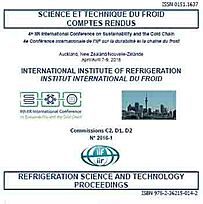
Document IIF
Incidences de la surfusion sur la découpe des filets congelés de saumon atlantique (salmo salar).
Effect of supercooling on the cutting of frozen Atlantic salmon (salmo salar) fillet.
Auteurs : LEE Y. J., WATANABE M., SUZUKI T.
Résumé
Supercooling is the process of lowering the temperature of a product below its initial freezing point without phase change. It is known that existence of supercooling state before freezing has significant influence on the structure of ice crystals. Automated cutting of salmon fillets is usually made in the partially frozen state. It would be expected that the partial freezing experiencing supercooling state improved the cutting process. The objective of this study was to evaluate the effect of supercooling before freezing (supercooling-freezing, abbreviated as SF) on the cutting of salmon fillet. The cutting test was conducted by using a texture analyzer. Samples were compressed to a 90 % strain with a knife probe. The maximum force was used for describing the cutting force. The microstructure was observed using light microscope. Our results showed that SF had influence on the microstructure and cutting force. The microstructure of SF sample showed less damaged cells than normal freezing. The cutting force for SF sample was lower than that for normally frozen salmon. In addition, there was no significant difference between the cutting forces for raw and SF samples.
Documents disponibles
Format PDF
Pages : 8
Disponible
Prix public
20 €
Prix membre*
Gratuit
* meilleur tarif applicable selon le type d'adhésion (voir le détail des avantages des adhésions individuelles et collectives)
Détails
- Titre original : Effect of supercooling on the cutting of frozen Atlantic salmon (salmo salar) fillet.
- Identifiant de la fiche : 30017548
- Langues : Anglais
- Source : 4th IIR International Conference on Sustainability and the Cold Chain. Proceedings: Auckland, New Zealand, April 7-9, 2016.
- Date d'édition : 07/04/2016
- DOI : http://dx.doi.org/10.18462/iir.iccc.2016.0002
Liens
Voir d'autres communications du même compte rendu (63)
Voir le compte rendu de la conférence
Indexation
-
Thèmes :
Congélation des aliments;
Poissons et produits de la mer - Mots-clés : Structure; Découpe; Surfusion; Saumon; Procédé; Congélation
-
Influence of fish freshness on the freezing pro...
- Auteurs : OZEKI A., WATANABE M., SUZUKI T.
- Date : 26/08/2020
- Langues : Anglais
- Source : 6th IIR International Conference on Sustainability and the Cold Chain. Proceedings: Nantes, France, August 26-28 2020
- Formats : Vidéo, PDF
Voir la fiche
-
Improving energy efficiency in seafood freezing...
- Auteurs : SVENDSEN E. S., INDERGÅRD E., BENGSCH J., WIDELL K. N., KOSTER L., NORDTVEDT T. S.
- Date : 11/06/2024
- Langues : Anglais
- Source : 8th IIR International Conference on Sustainability and the Cold Chain. Proceedings: June 9-11 2024
- Formats : PDF
Voir la fiche
-
Overview on the freeze-chilling of foods.
- Auteurs : GORMLEY T. R., FAGAN J. D., REDMOND G. A.
- Date : 01/2005
- Langues : Anglais
- Source : EUROFREEZE: Individual Quick Freezing of Foods - Workshop Proceedings, Sofia, Bulgaria, January 13-15, 2005.
- Formats : PDF
Voir la fiche
-
Handling, processing and freezing of pelagic fi...
- Auteurs : NORDTVEDT T. S., STAVSET O., WIDELL K. N.
- Date : 16/04/2015
- Langues : Anglais
- Source : 6th Conference on Ammonia and CO2 Refrigeration Technology. Proceedings: Ohrid, North Macedonia, April 16-18, 2015.
- Formats : PDF
Voir la fiche
-
Evaluation of microwave assisted freezing (MAF)...
- Auteurs : XANTHAKIS E., HUEN J., ELIASSON L., et al.
- Date : 06/04/2018
- Langues : Anglais
- Source : 5th IIR International Conference on Sustainability and the Cold Chain. Proceedings: Beijing, Chine, 6-8 avril 2018
- Formats : PDF
Voir la fiche
